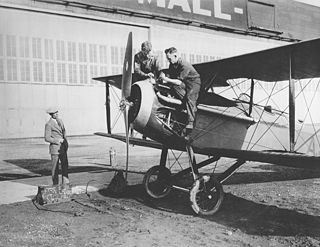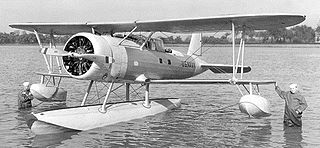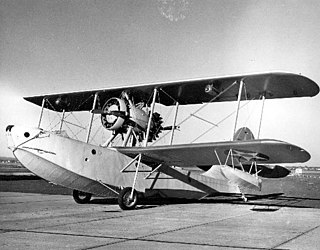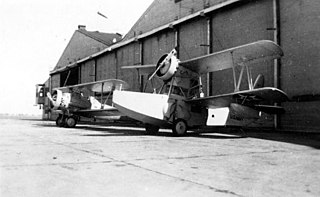
The Naval Aircraft Factory (NAF) was established by the United States Navy in 1918 in Philadelphia, Pennsylvania. It was created to help solve aircraft supply issues which faced the Navy Department upon the entry of the U.S. into World War I. The US Army’s requirements for an enormous quantity of airplanes created a decided lack of interest among aircraft manufacturers in the Navy's requirements for a comparatively small quantity of aircraft. The Navy Department concluded that it was necessary to build a Navy-owned aircraft factory in order to assure a part of its aircraft supply; to obtain cost data for the department’s guidance in its dealings with private manufacturers; and to have under its own control a factory capable of producing experimental designs.

The Vought OS2U Kingfisher is an American catapult-launched observation floatplane. It was a compact mid-wing monoplane, with a large central float and small stabilizing floats. Performance was modest because of its low-powered engine. The OS2U could also operate on fixed, wheeled, taildragger landing gear.

The Vought SB2U Vindicator is an American carrier-based dive bomber developed for the United States Navy in the 1930s, the first monoplane in this role. Vindicators still remained in service at the time of the Battle of Midway, but by 1943, all had been withdrawn to training units. It was known as the Chesapeake in Royal Navy service.

The Hall XPTBH was a prototype American twin-engined seaplane, submitted to the United States Navy by the Hall Aluminum Aircraft Corporation in response to a 1934 specification for new bomber and scout aircraft. Constructed in an innovative fashion that made extensive use of aluminum, the XPTBH proved successful in flight testing, but failed to win favor with the U.S. Navy. No production contract was awarded, and the single aircraft built served in experimental duties before its destruction in a hurricane during 1938.

The Curtiss SO3C Seamew was developed by the Curtiss-Wright Corporation as a replacement for the SOC Seagull as the United States Navy's standard floatplane scout. Curtiss named the SO3C the Seamew but in 1941 the US Navy began calling it by the name Seagull, the same name as the aircraft it replaced, causing some confusion. The British Royal Navy kept the Curtiss name, (Seamew), for the SO3Cs that they ordered. One of the US Navy's main design requirements was that the SOC Seagull's replacement had to be able to operate both from ocean vessels with a single center float and from land bases with the float replaced by a wheeled landing gear.

The Vought FU was a biplane fighter aircraft of the United States Navy in service during the late 1920s.

The Vought VE-7 "Bluebird" was an early biplane of the United States. First flying in 1917, it was designed as a two-seat trainer for the United States Army, then adopted by the United States Navy as its first fighter aircraft. In 1922, a VE-7 became the first airplane to take off from an American aircraft carrier.

The Curtiss Model R was a utility aircraft produced for the United States Army and Navy during World War I. It was a conventional, two-bay biplane with slightly staggered wings of unequal span. The aircraft was provided with two open cockpits in tandem and fixed tailskid undercarriage, but many were built for the Navy with twin floats replacing the wheels. During the course of the war, Model Rs were used for general liaison and communication duties, as well for observation, training, and as air ambulances. In practice, the Curtiss powerplants supplied with these aircraft proved insufficient and were mostly replaced with Liberty engines. The Navy's Model R-3 floatplane had extended-span, three-bay wings, and was intended for use as a torpedo bomber. Some of these were later fitted with wheeled undercarriage and transferred to the Army as bombers under the designation Model R-9.

The Grumman XSBF, also known by the company designation G-14, was an American biplane scout bomber developed by Grumman Aircraft for the United States Navy during the 1930s. Derived from Grumman's successful "Fifi" fighter, the aircraft was developed at a time when the biplane was giving way to the monoplane. In competition against other aircraft it proved to possess inferior performance in its intended role, and did not enter production. The sole prototype went on to serve as a liaison aircraft, as well as being used in experiments by NACA, before being destroyed in a crash in 1939.

The Vought XSB3U was an American biplane scout bomber developed by Vought-Sikorsky for the United States Navy during the 1930s. Developed as an alternative to the SB2U Vindicator monoplane, the aircraft proved unsatisfactory to the Navy in comparison, and development was not pursued.

The Berliner-Joyce OJ was an American biplane observation floatplane developed by the Berliner-Joyce Aircraft for the United States Navy during the early 1930s.

The Douglas XFD was a carrier-based biplane fighter aircraft designed for the United States Navy, and the first fighter to be built by the Douglas Aircraft Company. A victim of changing requirements, no production was undertaken.

The Douglas XO2D-1 was a prototype American observation floatplane of the 1930s. It was a single engined biplane intended to be launched by aircraft catapult from ships of the United States Navy, but only one was built, the production contract going to Curtiss for the SOC Seagull.

The Stearman XOSS was an American biplane observation floatplane developed by Stearman Aircraft for the United States Navy during the late 1930s. Intended to replace the Curtiss SOC Seagull in service aboard battleships, it proved inferior to the Vought OS2U Kingfisher in a fly-off, and did not enter production.

The Vought XSO2U was an American observation floatplane developed by Vought-Sikorsky for the United States Navy during the late 1930s. Intended to replace the Curtiss SOC Seagull in service as a scout aboard cruisers, it proved superior to the Curtiss SO3C in evaluation, but failed to win a production contract due to Vought's lack of manufacturing capacity.

The Consolidated XB2Y was an American prototype single-engined dive bomber of the 1930s. It was intended to meet a United States Navy requirement for a carrier-based dive bomber, but was unsuccessful, only a single example being built.

Naval Aircraft Factory NO was an American short-range reconnaissance/gun spotting aircraft of the 1920s. A single-engined three-seat biplane with alternative floats or wheels, six were built for the U.S. Navy.
The Keystone XOK was an American biplane observation floatplane developed for the United States Navy during the early 1930s.

The Sikorsky XP2S was an American biplane patrol flying boat developed for the United States Navy during the early 1930s.

The Loening XS2L was an American biplane scout amphibian developed by Keystone-Loening, for the United States Navy during the early 1930s.



















